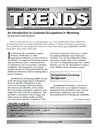Labor Market Information > Wyoming Labor Force Trends > September 2011 > News Release

Wyoming Unemployment Rate Falls to 5.8% in July 2011
The Research & Planning section of the Wyoming Department of Workforce Services has reported that the state's seasonally adjusted1 unemployment rate fell from 5.9% in June to 5.8% in July. It remained significantly lower than its July 2010 level of 6.9% and the current U.S. rate of 9.1%. For the second month in a row, seasonally adjusted employment fell slightly, decreasing by an estimated 845 people (-0.3%) from June to July.
Across Wyoming's 23 counties, the highest unemployment rates were found in Lincoln (6.6%), Fremont (6.3%), and Big Horn (6.2%) counties. Sublette County posted the lowest unemployment rate (3.0%). Several other counties reported unemployment rates lower than 5.0% (Campbell, 4.2%; Albany, 4.3%; Niobrara, 4.3%; Park, 4.4%; Converse, 4.4%; Teton, 4.6%; Sweetwater, 4.6%; Hot Springs, 4.6%; and Crook, 4.7%).
All unemployment rates followed their normal seasonal pattern and decreased from June to July. County unemployment rates usually decrease in the summer months as seasonal hiring occurs in construction, leisure & hospitality, retail trade, and other sectors. The largest unemployment rate decreases were seen in Park (down from 5.1% to 4.4%), Lincoln (down from 7.3% to 6.6%), and Albany (down from 5.0% to 4.3%) counties.
From July 2010 to July 2011 unemployment rates fell in every county, suggesting broad improvement in the state's economy. Three of the counties with the largest decreases in unemployment were found in the western part of the state (Sweetwater, down from 6.4% to 4.6%; Lincoln, down from 8.3% to 6.6%; and Uinta, down from 6.6% to 5.1%).
Total nonfarm employment stood at 295,400 jobs in July 2011, an increase of 7,100 jobs (2.5%) from July 2010.
1Seasonal adjustment is a statistical procedure to remove the impact of normal regularly recurring events (such as weather, major holidays, and the opening and closing of schools) from economic time series to better understand changes in economic conditions from month to month.

